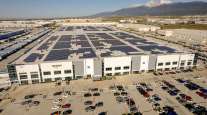Staff Reporter
New Truck Lanes Opened at Calexico Border With Mexico

Officials at the Nov. 15 ribbon-cutting, left to right: Tarcisio Navarrete, Mexican consulate in Calexico; Nikki Tiongco, Caltrans trade corridor director; Roque Caza, area port director, U.S. Customs and Border Protection; Amanda Sweeney, GSA branch chief; David Aguirre, Imperial County Transportation Commission; Mike Goodsell, Imperial County Transportation Commission chairman; Clarissa Falcon, California Transportation commissioner; and Tay Dam, FHWA senior transportation engineer. (GSA)
[Stay on top of transportation news: Get TTNews in your inbox.]
California and federal officials gathered Nov. 15 in Calexico to open a U.S. General Services Administration bridge expansion project to ease congestion for 453,000 commercial trucks crossing the U.S.-Mexico border there annually.
“Through this effort, the Imperial Valley will continue to grow and deliver economic opportunity to the region, state and nation as a whole,” said Amanda Sweeney, deputy regional commissioner of public buildings service for GSA’s Pacific Rim region. “GSA is proud to have worked with them on delivering this innovative project to the region.”
The Calexico East Land Port of Entry is located on State Route 7 about 120 miles east of San Diego and about 50 miles west of Yuma, Ariz.
GSA partnered in the $32.5 million project with the Imperial County Transportation Commission, the California Department of Transportation, the U.S. Department of Transportation and other regional partners for a comprehensive effort to update the aging port of entry.
The new bridge expansion completed the project’s first phase by opening two new northbound truck lanes.

The remaining portions of the Calexico project are on track for completion by the spring of 2024. (GSA)
David Aguirre, ICTC executive director, said when the project is complete there will be two new northbound passenger vehicle lanes at the border (to total five) and two additional northbound and southbound commercial vehicle lanes, raising the total to six, enabling “northbound traffic to flow more efficiently and reduce traffic wait times.”
Other construction will add a pedestrian crossing, an eight-foot shoulder for out-of-service vehicles, new concrete barriers and minor modifications to landscaping, drainage, signage and lighting. The project is scheduled to be done by spring of 2024.
According to GSA, U.S. project partners in the Calexico East border crossing upgrade continue to coordinate with their counterparts in Mexico to fully maximize bilateral port improvements. Mexico is in the process of completing infrastructure improvements to its adjacent port facility.
The Calexico East port has been unable to keep pace with modern trade and passenger flows. Each year, trucks traveling over the border there carry $20 billion in exports and imports. In addition, 2.6 million vehicles enter the United States through the Calexico East crossing.
Caltrans District Director Gustavo Dallarda said, “Across the state, nobody understands and appreciates the special relationship between the United States and Mexico better than our border communities.” He said Caltrans is honored to partner with ICTC to build infrastructure connecting California with Mexico while improving Imperial County’s port of entry freight facilities in Calexico.
Maps shows Calexico (red pin) in relation to San Diego and Yuma, Ariz. (green pins) (Google Maps)
The new commercial truck lanes will provide better lane segmentation and improve the U.S. Customs and Border Protection agency’s ability to better use its inspection infrastructure.
“With reduced traffic congestion, we pave the way for improved accessibility, fostering economic development and strengthening the bonds that tie us together,” said Roque Caza, CBP’s Calexico area port director.
The project is being paid for by local transportation allocations ($2 million for design, construction and construction management). California provided $3 million for a project study report and $7.5 million from its Trade Corridor Enhancement Program. A $20 million grant came from the Federal Highway Administration’s Better Utilizing Infrastructure to Leverage Development (BUILD) program.
GSA, as the federal government’s landlord, used its gift acceptance authority to receive transportation-related infrastructure improvements from the ICTC.

Mary Simms
GSA spokesperson Mary Simms said the agency’s port modernization and expansion projects “will make a significant impact to improve the border-crossing experience, better facilitate trade and spur regional economic growth for border communities in southern California and Arizona.”
ICTC council member Mike Goodsell said, “The completed project will provide much-needed infrastructure to further facilitate goods movement, reduce emissions created by idling vehicles and improve the port crossing experience for passenger vehicles and walking pedestrians alike.”
Want more news? Listen to today's daily briefing below or go here for more info:




